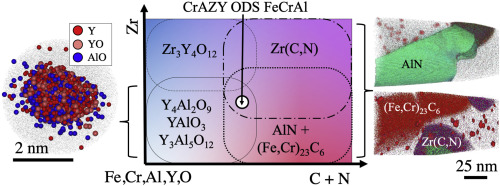Journal of Nuclear Materials ( IF 2.8 ) Pub Date : 2020-03-24 , DOI: 10.1016/j.jnucmat.2020.152105 Caleb P. Massey , Philip D. Edmondson , Kinga A. Unocic , Ying Yang , Sebastien N. Dryepondt , Anoop Kini , Baptiste Gault , Kurt A. Terrani , Steven J. Zinkle

|
Oxide dispersion strengthened (ODS) FeCrAl alloys are promising candidate materials for advanced nuclear reactor applications requiring high-temperature strength, corrosion resistance, and irradiation tolerance. As these alloys have increased in compositional complexity through attempts to use highly reactive elements such as Zr to refine particle sizes and optimize nanoprecipitate dispersion characteristics, much debate has ensued as to the effects of these alloying element additions on alloy properties. In an attempt to reconcile differences in nanoprecipitate distributions reported in the literature over the past decade, a detailed investigation of a recently developed ODS FeCrAl alloy with nominal composition Fe–10Cr-6.1Al-0.3Zr+0.3Y2O3 is presented using a combination of atom probe tomography (APT), scanning/transmission electron microscopy (S/TEM), and computational thermodynamics modeling. It is illustrated that based on the amount of Zr available in the lattice, Zr competes with Al and Cr to form carbides and nitrides as opposed to oxygen-rich precipitates. This alloy system has a high number density (>1023 m−3) of ∼2–4 nm diameter (Y,Al,O)-rich nanoprecipitates, but it is shown that due to the compositional spread and unknown partitioning of Al between the matrix and precipitates, significant challenges still exist for quantifying the exact compositions of these precipitates using APT. However, the noted compositional spread is supported by identified complex oxides yttrium aluminum monoclinic (YAM) and yttrium aluminum garnet (YAG) using S/TEM. As a result of these findings, researchers developing ODS FeCrAl with reactive element additions must pay careful attention to C and N impurities when optimizing reactive element additions.
中文翻译:

Zr对氧化物弥散强化FeCrAl合金中析出的影响
氧化物弥散增强(ODS)FeCrAl合金是有前途的候选材料,适用于需要高温强度,耐腐蚀性和耐辐射性的先进核反应堆应用。由于这些合金通过尝试使用高反应性元素(例如Zr)来细化粒度并优化纳米沉淀物的分散特性而增加了成分复杂性,因此,关于这些合金元素的添加对合金性能的影响引起了很多争论。为了调和过去十年文献中报道的纳米沉淀分布的差异,对最近开发的标称成分为Fe-10Cr-6.1Al-0.3Zr + 0.3Y 2 O 3的ODS FeCrAl合金进行了详细研究。结合使用原子探针层析成像(APT),扫描/透射电子显微镜(S / TEM)和计算热力学模型进行了分析。结果表明,基于晶格中可用的Zr量,Zr与Al和Cr竞争,形成碳化物和氮化物,而不是富氧的沉淀物。该合金系统具有很高的数密度(> 10 23 m -3)直径约2-4 nm(Y,Al,O)的纳米沉淀,但结果表明,由于基体和沉淀物之间的成分扩散和未知的Al分配,对于量化Al2O3的确切组成仍然存在重大挑战使用APT沉淀这些沉淀物。但是,使用S / TEM鉴定的复合氧化物钇铝单斜晶(YAM)和钇铝石榴石(YAG)可以支持上述组成分布。这些发现的结果是,开发具有反应性元素添加量的ODS FeCrAl的研究人员在优化反应性元素添加量时必须特别注意C和N杂质。











































 京公网安备 11010802027423号
京公网安备 11010802027423号